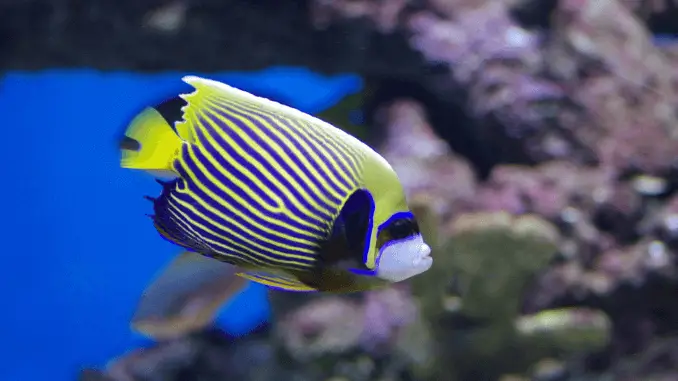
The emperor angelfish is a saltwater fish of the Pomacanthus family. A mature emperor angelfish has yellow and blue horizontal stripes, while a juvenile has white and dark blue arch-like bands.
These fish are popular among aquarists because of their unique coloring — no other saltwater angelfish has yellow and blue stripes.
Because of their semi-aggressive and territorial nature, emperor angelfish are incompatible with other fish, need a moderate amount of care, and need a very large tank. This species is also expensive.
TABLE OF CONTENTS
Emperor Angelfish Facts & Overview

| Scientific name: | Pomacanthus imperator |
| Common names: | Emperor angelfish, imperial angelfish, or imperator angelfish |
| Distribution: | Red Sea, East Africa, Japan, Great Barrier Reef (Australia), French Polynesia, Hawaii, Florida, and Puerto Rico |
| Size: | Up to 12 inches in captivity, and up to 15 inches in the wild |
| Life expectancy: | 20+ years |
| Color: | Blue-black with alternating yellow and blue stripes |
| Diet: | Omnivore |
| Temperament: | Semi-aggressive |
| Minimum tank size: | 125 gallons (juveniles) 200 gallons (adults) |
| Temperature: | 72–82°F (22.2–27.7°C) |
| pH: | 8.1–8.4 |
| Hardness: | 8–12 dKH |
| Care level: | Moderate to difficult |
| Breeding: | Egg-laying |
Origin
Emperor angelfish are common in the wild and found in the Red Sea, East Africa (most notably Mozambique and Madagascar), Japan, the Great Barrier Reef in Australia, and French Polynesia — New Caledonia, Rapa, Marquesas Islands, Austral Islands, Line Islands, Tuamotu Islands, and Easter Island.
These fish have also been spotted in Hawaii, Puerto Rico, and Florida, most likely because hobby aquarists release the fish into the water. There have also been reports of emperor angelfish colonizing the southwestern Mediterranean as an invader species.
In the wild, these fish swim at depths of 3.3–328.1 feet. Adult emperor angelfish live in caves and underneath ledges in the calmer waters of coral reefs. Subadults live where meals are plentiful: reef holes and cavities in seaward reef surge channels. Juveniles can be found living alone on the shallow reef outskirts in sheltered areas.
Adult Size & Lifespan
In the wild, a full-grown emperor angelfish grows to 15 inches in length. In captivity, these fish usually grow to 12 inches long. Males are usually bigger than females.
The average lifespan of a well-cared-for emperor angelfish in captivity is 20 or more years. In the ocean and open water, these fish live up to around 15 years.
Availability
Emperor angelfish are readily available in pet stores and online shops. A juvenile costs $129–$199, a subadult costs roughly $239 or more, and an adult costs $399–$1,400.
Emperor angelfish are available from these online stores:
Appearance & Behavior

The emperor angelfish has a flat, wide body striped in colors of blue, black, yellow, and white. Adults don’t look the same as juveniles, as the bands and colors of this species are quite different during each life stage.
Like other angelfish, this fish is quite territorial and semi-aggressive.
Colors, Patterns, Fins, and Sex Differences
Juvenile emperor angelfish look similar to the juvenile Koran angelfish or semicircle angelfish (Pomacanthus semicirculatus), as the fish both have a blue-black body with white centrally coordinated bands.
In the wild, juveniles keep their colors for two years, or until they grow to 3–5 inches in length. In captivity, juvenile emperor angelfish may keep these colors for longer.
When the juvenile colors start to fade, the fish phases into the subadult stage and its body becomes rounder and longer, develops yellow and blue stripes, and the tail fin changes to a solid yellow.
Adult or fully mature emperor angelfish have a slightly elongated oval body, and alternating blue and yellow horizontal bands along their flanks. The adult’s nape is light greenish-yellow, and its face is a light blue with a black and blue eye mask. The adult has a white-tipped dorsal fin, yellow tail fin, and light-blue and dark-blue striped anal fin.
Male and female emperor angelfish look alike, though males have a more bluish face, while females have a grayish face and look less vibrant.
Typical Behavior
Even though emperor angelfish may be shy when introduced to a tank, the fish are semi-aggressive, especially toward other emperor angelfish males, angelfish that are similar in color and body shape, and smaller fish. These fish are also territorial, and grunt or make a knocking sound when they feel threatened.
The species needs plenty of swimming space in the tank, but it also likes to hide in caves and behind rocks. These fish enjoy all regions of the aquarium.
Emperor Angelfish Care & Tank Requirements

Emperor angelfish are moderately difficult fish to take care of. These fish need to be introduced to a large, established tank because the fish stress easily in new or small tanks. The tank’s water quality needs to be carefully maintained to prevent disease and death. Emperor fish are dominant, so take care when choosing tank mates.
Tank conditions should closely mimic their natural saltwater habitat, with the right lighting, temperature, slightly alkaline and slow-moving water, and decor like plants, rocks, and artificial reefs.
Emperor angelfish are omnivores. Feed them flake food, pellets, or tablets (with sponge material and spirulina included), live food, and vegetables.
Habitat and Tank Requirements
In the ocean, emperor angelfish typically inhabit territories as large as 10,000 square feet. The fish are found alone, in pairs, or living in harems.
While a saltwater tank isn’t as big as natural territories, the tank should at least hold 200 gallons for one or a bonded pair (male and female) of adult emperor angelfish. Keep one juvenile in a minimum 125-gallon tank, and a pair in a 185-gallon tank. Keeping a harem of emperor angelfish (one male and several females) requires a much larger tank.
A large tank that isn’t overcrowded with other fish and decorations provides ample swimming space for the emperor angelfish. Plenty of rockwork and caves are needed for the fish to hide in when it feels stressed. Saltwater plants like turtle grass shoots, mermaid’s fan, green finger plant, halimeda, and dragon’s tongue algae also give the emperor angelfish hiding space and something to nibble on.
In the wild, emperor angelfish live in tropical waters, so the tank’s water temperature should be slightly warm, at 72–82°F. Because the average pH of the ocean is 8.1, the water in the tank should also be slightly alkaline to mimic the fish’s natural environment.
A strong filtration system is also recommended to cycle the tank and regulate pH levels because these fish produce a lot of waste. Add a bright light to the tank to bring out the fish’s colors and to help prevent disease.
The emperor angelfish also hangs out in sea reefs, so you may opt for a reef tank with live rocks, corals, and bright lighting. The live rocks provide a food source and a place where the emperor angelfish can hide. Choose small polyp stony (SPS) corals, disc anemone, star polyps, bubble corals, and hammer corals.
Tank Conditions
The emperor angelfish needs the following tank conditions to thrive:
| Water type: | Slow-moving saltwater |
| Tank size: | Minimum 200 gallons (one or a pair of adults), or minimum 125 gallons (one juvenile) |
| Water temperature: | 72–82°F |
| Substrate: | Any |
| Tank setup: | Lighting, caves, rockwork, live rock, plants, (optional) corals |
| Acidity: | 8.1–8.4 pH |
| Water hardness: | 8–12 dKH |
| Filter: | Yes, to help reduce waste |
| Specific gravity: | 1.020–1.025 SG (1.023 is ideal) |
The emperor angelfish needs lots of swimming space and hiding spots in a large-sized tank. Ensure the water requirements mimic this species’ tropical-water habitat.
Disease
Emperor angelfish are hardy, but they are susceptible to diseases if the fish are stressed or if there are parasites in the tank’s water. The most common diseases that can affect this fish species are ich, head and lateral line erosion disease, and marine velvet.
Ich
Ich, also called white spot disease or crypt, is caused by a parasite. Affected fish have small white spots on their skin and fins, and the fish scratch against rocks and other objects in the tank to relieve itchiness.
Quarantine the affected fish and treat them with copper, while sanitizing the main tank.
Head and Lateral Line Erosion
Head and lateral line erosion disease, also called hole-in-the-head disease, affects the lateral line organ and the skin that covers the fish’s head and face. Erosive lesions form along these areas. Causes can include nutrient deficiencies, activated carbon, parasites, and carbon dust.
Treatment for hole-in-the-head disease includes anti-parasitic medication, proper tank maintenance, and ensuring the emperor angelfish aren’t stressed. Prevention for this disease includes lighting the tank with a bright light and keeping the tank in ideal conditions.
Marine Velvet
Marine velvet is also caused by parasites. Affected fish will have gold spots on their bodies and the gills may become inflamed and bleed. Copper is the most effective treatment option.
Prevent marine velvet by quarantining new fish for a few weeks before adding them to an established tank, maintain the tank conditions, and ensure the emperor angelfish doesn’t feel stressed.
Tank Mates
Because emperor angelfish are semi-aggressive, introduce this species to a tank only after introducing its tank mates to help curb territorial behavior. Never keep two male adults in the same tank. You can keep one emperor angelfish, a bonded pair, or even one male and two females together.
The large emperor angelfish is known to bully smaller or peaceful fish, as well as other angelfish that are visually similar.
Suitable tank mates for the emperor angelfish are:
- Dottybacks
- Six-line and 8-line wrasse
- Damselfish
- Tangs
- Large wrasses
- Butterflyfish like the raccoon, yellow longnose, and copperband
- Flame, coral beauty, swallowtail angelfish
- Lionfish
- Groupers
- Pufferfish
- Rabbit snails
- Starfish
- Mini brittle stars
- Copepods
- Amphipods
Unsuitable tank mates for the emperor angelfish are:
- Gobies
- Dartfish
- Assessors
- Fairy wrasses
- Anthias
- Clownfish
- Dwarf angels
- Seahorses
- Mandarins
- Pipefish
- Sea fans
- Shrimp
- Crabs
- Snails
- Clams
- Oysters
- Scallops
- Anemones
- Sea stars
Diet and Feeding
Emperor angelfish are janitor fish since the fish eat most food they can find in their natural environment. Feed these omnivore emperors a variety of animal and plant-based foods.
Only feed as much as the fish can eat in five minutes and then remove any uneaten food to keep the tank water clean. In a tank with more than one of this species, scatter food throughout the tank to ensure all emperor angelfish get to eat.
Popular foods for the emperor angelfish are:
- Spirulina
- Marine algae
- Shrimp or brine/mysis shrimp
- Squid
- Scallops
- Clams
- Spinach
- Sponge (Porifera)
- Flake food
- Pellets or tablets
- Corals
- Dried seaweed
Breeding
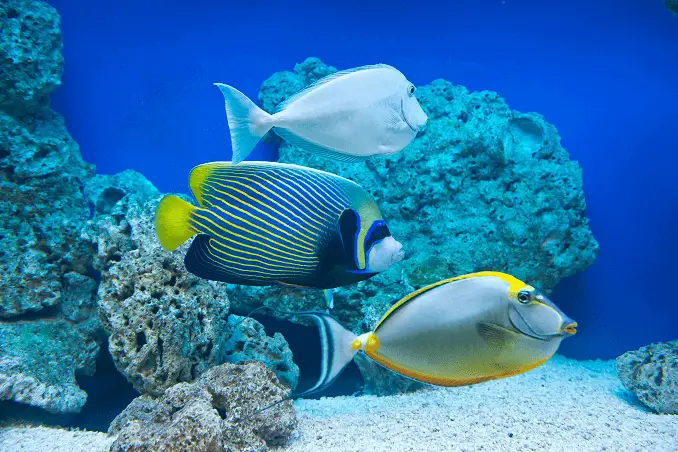
It isn’t recommended to breed emperor angelfish in captivity because achieving the specific breeding conditions the fish require (like massive open space) is difficult.
Choosing your Emperor Angelfish
Emperor Angelfish do not ship well and are prone to stress, so it’s important you choose a fish that is healthy.
Ideally, when you choose an emperor angelfish, you should buy a juvenile that is around 4–6 inches long, as they find it easier to adapt to captivity. Make sure they are active and curious about their environment.
Check their gill count; if it’s over 80 a minute and they are swimming calmly, take this as a red flag. If the fish appear overly bright and disorientated, they might have been treated with cyanide – again another red flag.
You may find that the colors aren’t as bright as wild emperor angelfish. If this is the case, you can use color enhancers in their food to improve their color.
Should You Get an Emperor Angelfish for Your Aquarium?
An emperor angelfish is a good addition to a large tank where other semi-aggressive to aggressive fish species thrive. However, emperor angelfish aren’t a good option if you have a small tank or a peaceful fish population, since emperor angelfish bully passive fish and feel trapped in a small tank.
Despite compatibility issues, the emperor angelfish — a juvenile with concentric-like circles, or an adult with horizontal bands — is a beautiful fish to have in your tank.




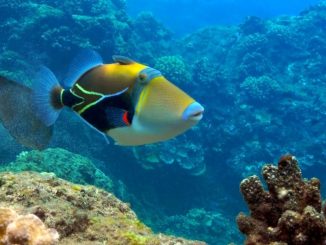
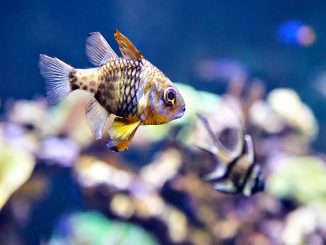
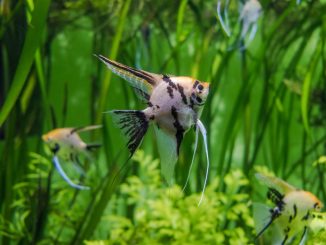

I would like to have a emperor angel and a queen angel.
do you feel this would be a bad idea.
my tank is 220 gallons
Hi Sue, they do look quite similar and usually Angelfish are quite aggressive to those within the same species so I’d be tempted to advise against it. If you do choose to, make sure you follow the advise in the article. Thanks, Robert
Most literature and expert’s opinion say that it would not be advised to have an Emperor Angelfish and a Queen Angelfish.
This does not mean it cannot work in your tank but you need to know that there are some risks.
I have a Queen Angelfish, an Emperor Angelfish, a Flame Angelfish and a Singapore Angelfish in a 130 gallon tank since almost 2 years, along with other fish, and they are all doing great
I have had Emperor Angel Fish before but they both ended up with Lateral line Disease. I have had my junior Emperor for over a year now and it he looks awesome. He is growing and so far no sign of Lateral Line Disease. I am feeding him Tetra Colour along with store bough sea weed mixed into it. He is in a 125 us gallon tank with 3 damsels and a Yellow Tang. I also have some hardy corals and lots of live rock. I do hear some grunting after the lights are turned off at night. Any suggestions to make a happy healthy fish even better?
Hi James, great to hear your Emperor Angel Fish is doing so well. If you follow all the tips in this article, hopefully he will continue to thrive! Robert
I have a 6″ emperor angel, and was hoping to add a french angel to my tank. They are very different looking fish and both very impressive fish as adults. Any tips to achieve tank harmony with these two? Or is it just a bad idea?